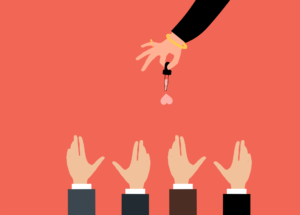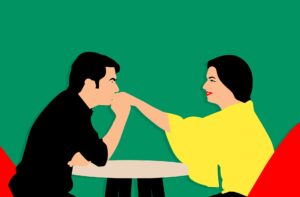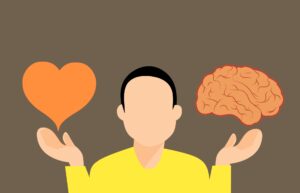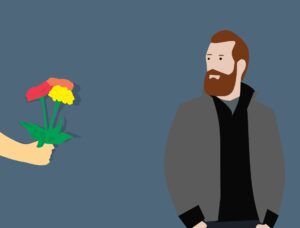
Love is the eternal subject that people chase after. For those searching for love, it is the lighthouse emanating across the dark ocean. For those in love, it is the key to heaven that makes life divine. This affection seems so transcendent that it exceeds any rational explanation, but during the hard part of the night, listening to the hooting owl outside the window, have you ever wondered: What is love?

The History. The conceptualization of love is dated back to Augustine and Thomas Aquinas in their construct of ideology from human to God. The brilliant philosophers directed the vocabulary of love to Caritas – the Latin word for love and compassion. Caritas is the synthesis of Eros and Agape: the sensual romantic love between humans and the selfless unlimited love from God to all. The biblical principles of Eros and Agape as the ascending flame and descending love is later applied to human love as a conventionalized medieval tradition named courtly love. Courtly love ennobles both men and women and establishes their unity in an intense, passionate relationship. During the Romanticism movement, the equality, similarities, and complementarities between partners were added to the tenets of the ideology of courtly love. While the ways of courtship have changed since the eighteenth century, one’s longing for romantic love resonated throughout the revolution of society and is still present today.
The Present. Pages of works of literature and countless media trace the glory of romantic love as the strive for fulfillment for one to go through the bleakness of life, augmenting the innate human desire to be loved. Unfortunately, dating in a world of rapid change and an overgrown population comes with elevated dissatisfaction. With the dating pool expanding from just people within one’s social circle to tens of thousands of people – if not more – engaged through a hyper-connected world, the opportunities come with challenges. The danger in meeting up with a complete stranger, the difficulty in finding someone whom one wants to date, the awkward silence after the initial How are you and Where are you from, and the confusion about whether this is love after the initial excitement and fulfillment – all of which add to the complexity of dating today.
How does a connection establish during a date?
How is one attracted to another?
How does one fall in love?
The answer – according to scientists in the fields ranging from cognitive and behavioral psychology to affective neuroscience and physiology – is both simple and complex.

The Verbal Communication. Verbal interaction drives intimacy through the communication of inner feelings, the expression of empathy for the other, and the offering of emotional support. Such verbal communication can establish intimacy through the expression of care and love, along with mutual disclosure of personal information in a positive feeling motivated to benefit the other. The modern dating regime where both parties start by exchanging personal information and feelings is the first step to establishing a closeness between strangers. However, merely a one-sided confession is not enough. The disclosure of inner thoughts and emotions should not only provide a positive feeling for the person sharing but also generate a welcoming and favorable response from the recipient.
Once established, intimacy developed through open, honest, and respectful verbal interaction builds up the feeling of closeness and affection between one another. However, verbal communication is only half the presentation of connection and attraction. In Love Is Blind — the popular Netflix reality dating show, people hoping to find love and searching for the One go on a series of blind dates, with no other means of interaction other than talking through isolating chambers. While the show is set on the claim that emotional intimacy built through pure verbal communication is sufficient for a sustainable joyful relationship, engaged audiences can tell that fulfilling verbal engagement does not just happen randomly, nor is it enough for one to fall in love.

The Nonverbal Interaction. Not everything can be expressed with words. Messages of attraction can be sent through diverse nonverbal signals from one’s body gestures and postures, facial expression, and one’s eye contact and movement. Studies have demonstrated that nonverbal behaviors such as eye contact, smiling, and head nods convey interest in attraction, intimacy, and openness to courtship. As a matter of fact, the physical synchrony of kinesics behaviors sparks affection as people with behavioral motions adjusted to their partners during a date are more likely to be romantically attracted to each other. While one might argue that these nonverbal visible signals can be intentionally regulated, the human body is more honest than people think. Contrary to visible behavioral adaptations, physiological changes are unconscious and difficult to regulate, therefore physiological behavioral adaptations capture sincere emotional exchange. Upon both verbal and nonverbal interactions during a date, synchrony in skin conductance and heart rate promotes attraction. The physical expression one gives may not always align with one’s physiology. However, when the synchrony of non-verbal interaction aligns, a deeper emotional transfer occurs between two people thereby, promoting their attraction to each other and establishing intimacy with the potential for love.

The Love Hormones. The synchronized heart pumping upon attraction and intimacy blooms from the firing brain, most specifically, the buried region named the ventral tegmental area (VTA). The VTA ignites the spark of attraction through the release of dopamine. Dopamine is a well-publicized hormone and neurotransmitter that is associated with feelings of motivation, pleasure, and satisfaction. Activities that trigger a rush of dopamine upon interaction with someone are recognized by the brain for future reference in order to pursue more rewards. The need to re-experience the increasing level of dopamine drives the sensation of euphoria and desire, which develops into a growing attraction to the recipient of one’s affection.
Studies have shown that when viewing photographs of one’s partner as compared to friends, specialized regions of the brain such as the VTA are activated to generate elevated levels of dopamine. The rewarding pathways downstream of dopamine promotes the release of adrenaline — a hormone that is involved in regulating visceral functions including respiration, muscle contraction, and heart rates. The stimulated production of adrenaline races the heart and sweats the palms, translating the neuronal responses of attraction to physical arousal and heightening the desire. While adrenaline augments the reward-seeking behavior of dopamine, oxytocin supports such motivation by expressing affiliative behavior. Oxytocin is produced in the hypothalamus of the brain and is constantly released during childbirth, breastfeeding, and sexual intercourse to drive the innate wish for bonding. The release of these love hormones supplements the rush of pleasure raised from connection, makes one feel rewarded, and augments the translation from affection to love.

The wheels of affection start turning from the moment two people sit down facing each other. Little things such as a mutual opinion on an upcoming movie and the unconscious synchrony when sharing a plate of pasta spark initial intimacy. The release of dopamine and adrenaline grows the seeded sense of liking into attraction. Oxytocin supplements the attraction with the desire for bonding — translating the connection to attachment and eventually love. There have been more and more biological and cognitive rationales as to why and how people experience the sensation of love. It is without a doubt that scientists will continue to work through interdisciplinary angles for an ultimate formulation of the laws of attraction. However, in the end, love is subjective among individuals, and there is certainly not just one definition of love. Extending beyond the love of romance discussed here, there is the love for one’s job, one’s friends, one’s family, and most importantly, the love for oneself. Great love – whether romantic or not – guides the path from self-discovery to self-acceptance and makes one aglow.
Peer Editor: Shea Ricketts